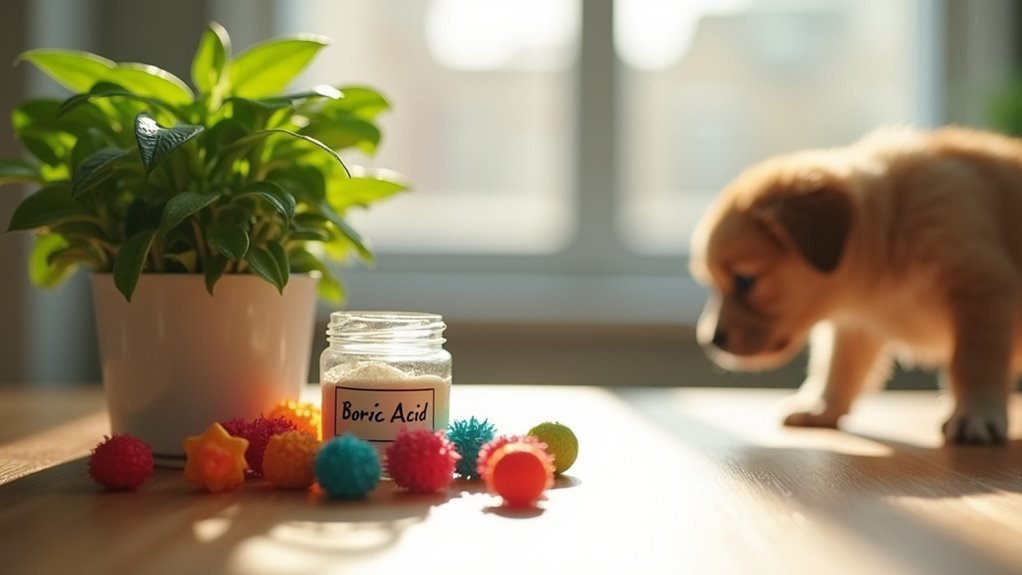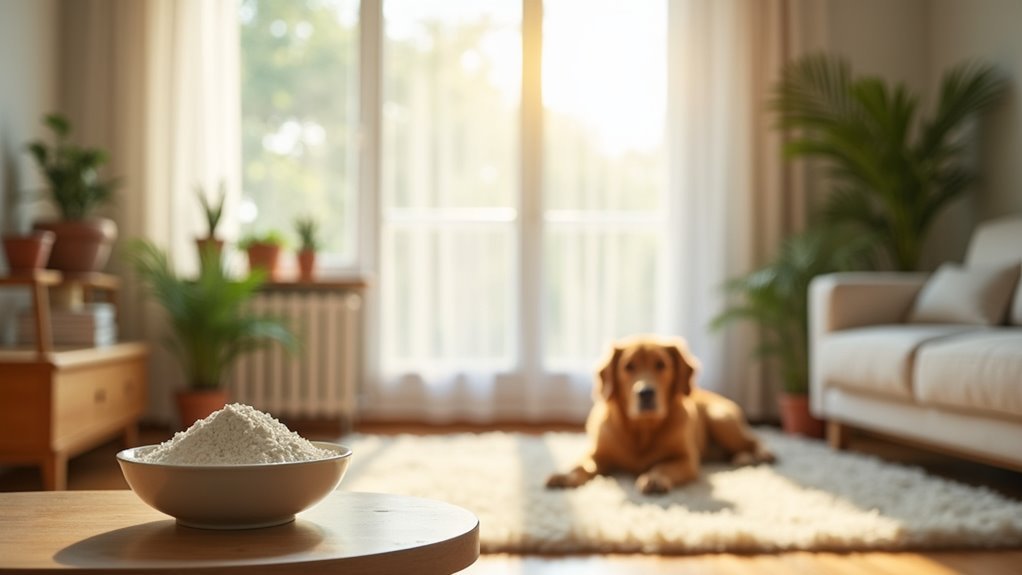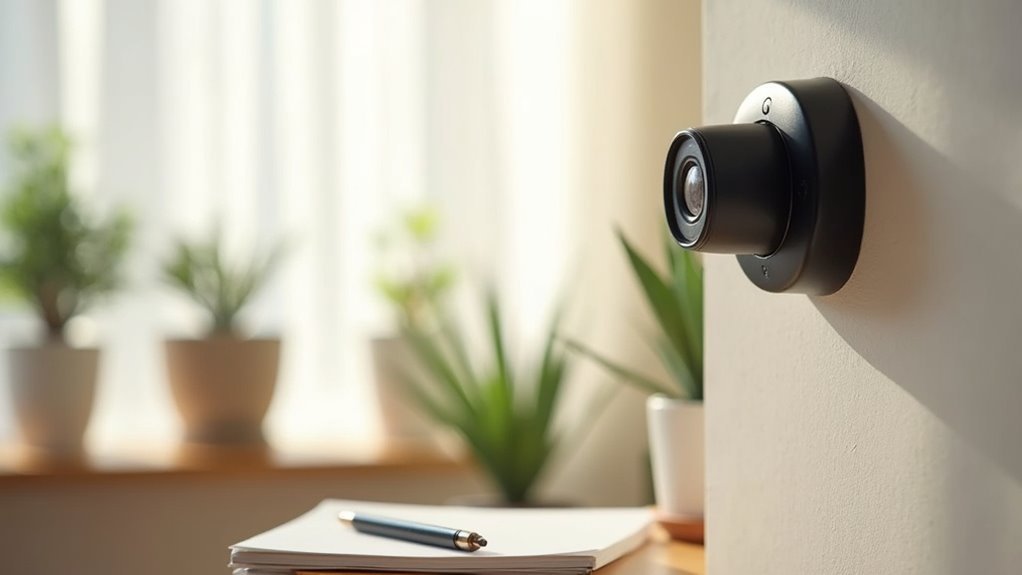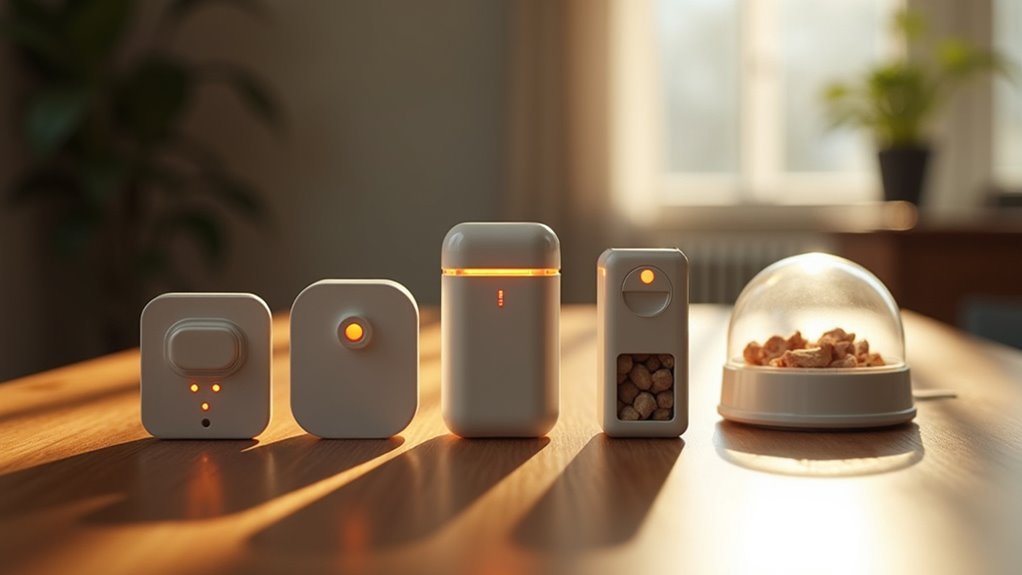You can safely use boric acid for pest control around pets by applying it in inaccessible areas like behind appliances and inside wall voids. Choose boric acid over borax since it’s less toxic and more effective against cockroaches and ants. Keep pets away from treated surfaces until they’re completely dry, and immediately clean up any visible residue. Store the product in labeled containers away from your furry friends, and monitor for any signs of gastrointestinal distress. Discover additional pet-safe strategies that’ll maximize your pest control success.
What Is Boric Acid and How Does It Work Against Pests

One of the most effective yet pet-safer pest control solutions you’ll find is boric acid, a naturally-derived chemical compound that targets insects through a unique dual-action mechanism.
This insecticide works by disrupting pests’ stomach function and nervous system when they ingest it during grooming. You’ll see particularly strong results against cockroaches and ants, as the compound slowly accumulates in their bodies, creating delayed effects that help spread the poison throughout entire colonies.
Boric acid causes cellular damage and dehydration in insects, making it highly effective for long-term population control.
Boric acid delivers lasting pest elimination by causing severe cellular breakdown and moisture loss in target insects.
What makes this pest control method appealing is its low toxicity profile compared to conventional pesticides, making it considerably safe for pets when you follow proper application guidelines.
Boric Acid vs. Borax: Choosing the Right Product for Pet Safety
When you’re choosing between boric acid and borax for pest control, you’ll find considerable differences in their chemical composition that directly impact both effectiveness and pet safety.
Boric acid poses lower toxicity risks to your pets compared to borax, which can be more dangerous if your furry friends accidentally ingest larger amounts.
You’ll also discover that boric acid markedly outperforms borax in actually eliminating pests through its unique delayed-action mechanism.
Chemical Composition Differences
Although both boric acid and borax contain boron as their base element, they’re fundamentally different chemical compounds with distinct safety profiles for pet owners.
Understanding these differences helps you make informed decisions about pest control methods in your home.
The key distinctions include:
- Toxicity levels – Boric acid demonstrates low toxicity when used as directed, making it safe for use around pets, while borax poses greater ingestion risks.
- Chemical structure – Each compound has different molecular compositions that affect their safety and effectiveness.
- Risk assessment – Boric acid’s lower toxicity profile makes it the preferred choice for households with animals.
When selecting pest control solutions, boric acid’s chemical makeup provides effective insect elimination while maintaining better safety margins for your pets compared to borax alternatives.
Pet Toxicity Levels
Pet owners face considerably different risk levels when choosing between boric acid and borax for pest control applications.
Boric acid safe usage poses minimal threats to your pets when you follow label instructions carefully. The EPA’s registration confirms its suitability for homes with children and pets present.
Borax presents higher toxicity levels, making boric acid the smarter choice for pet safe environments. While contact with boric acid might cause mild symptoms like vomiting or lethargy in pets, serious poisoning rarely occurs with proper application.
However, any pesticide remains potentially harmful if misused. You should always store products away from curious pets and avoid treating areas where they frequently spend time to minimize exposure risks.
Effectiveness Against Pests
Beyond safety considerations, you’ll want to choose the product that actually eliminates your pest problem effectively.
Boric acid proves superior to borax for pest control applications. When you use boric acid against cockroaches and ants, it disrupts their nervous systems upon ingestion while dehydrating them and causing cellular damage.
Here’s why boric acid outperforms borax for pest elimination:
- Targeted action – Specifically designed to affect insect biology rather than just cleaning
- Colony elimination – Delayed effects allow pests to carry poison back to nests
- Higher potency – More concentrated insecticidal properties than borax
The delayed-action mechanism makes boric acid particularly effective since infected insects become carriers, spreading the treatment throughout entire colonies.
You’ll achieve better results while maintaining safe use around pets compared to borax’s limited pest control capabilities.
Safe Application Methods to Protect Your Pets
When you’re ready to apply boric acid for pest control, strategic placement becomes your most powerful tool for keeping pets safe.
Focus on inaccessible areas like behind appliances and inside wall voids where pets can’t reach. Target corners and pest pathways while ensuring the powder remains invisible and unreachable.
For pet-friendly roach control, choose gel baits with gentler active ingredients and push them deep into cracks.
Using boric acid requires patience—keep pets away until dust settles and surfaces dry completely, preventing potential skin irritation from contact or inhalation.
Clean up visible residue immediately after treatment.
This targeted approach eliminates pests effectively while minimizing exposure risks, making your home safer for both family and furry companions.
Strategic Placement Areas Away From Pet Access

You’ll want to focus on hidden areas where your pets can’t reach when applying boric acid for pest control.
Behind appliance gaps and inside wall voids offer perfect placement opportunities since they’re naturally inaccessible to curious dogs and cats.
These concealed locations allow the boric acid to work effectively against pests while keeping your furry friends completely safe from exposure.
Behind Appliance Gaps
Strategic placement behind appliances creates one of the safest zones for applying boric acid while keeping your pets completely out of harm’s way.
These concealed areas provide excellent roach control opportunities since pests frequently hide in these spaces while remaining inaccessible to curious animals.
Focus on these key application areas:
- Refrigerator and stove gaps – Apply thin layers where appliances meet walls, targeting roach highways without pet contact.
- Behind water heaters and washers – Place boric acid powder in these moisture-rich hiding spots that attract roaches.
- Under dishwashers and ovens – Dust hard-to-reach spaces where roaches nest.
You’ll need to refresh applications every few weeks and seal gaps around pets for maximum effectiveness.
Always follow manufacturer guidelines for safe application periods.
Inside Wall Voids
Inside wall voids offer an ideal pest control sanctuary where boric acid can eliminate roaches without any risk of pet exposure.
These hollow spaces behind drywall provide perfect application zones since they’re completely inaccessible to people and pets. Use a narrow applicator to direct the powder precisely into these wall voids, ensuring accurate placement without spillage into living areas.
Apply small amounts rather than excessive quantities, as too much product can migrate and create unwanted residues. This measured approach maintains effective safe pest control while protecting your furry family members.
Regularly inspect treated areas to verify the boric acid remains contained and undisturbed. Always follow label instructions and allow complete drying before pets return to nearby spaces.
Recognizing Signs of Pet Exposure and What to Do
While boric acid can be an effective pest control solution, recognizing the warning signs of pet exposure is essential for keeping your furry friends safe.
Boric acid can cause serious health issues in pets, so you’ll need to watch for these signs of pet exposure:
- Vomiting and nausea – Your pet may show digestive upset shortly after contact.
- Lethargy or unusual tiredness – Watch for decreased energy levels or reluctance to play.
- Gastrointestinal distress – Look for diarrhea, loss of appetite, or abdominal discomfort.
Monitor pets closely after applying any boric acid treatments. If you notice these symptoms, seek veterinary assistance immediately for proper evaluation and treatment.
Keep pets away from treated areas for at least 24 hours and always follow product label instructions to minimize exposure risks.
Combining Boric Acid With Other Pet-Safe Pest Control Methods

Beyond monitoring your pets for signs of exposure, you can enhance boric acid’s effectiveness by pairing it with other pet-safe pest control methods.
Combine boric acid with food-grade diatomaceous earth for dual action—boric acid disrupts roaches’ nervous systems while diatomaceous earth dehydrates them.
Add rosemary oil as a natural repellent to deter roaches from treated areas without harming pets.
Use gel baits alongside boric acid to target active roaches and hidden nests, placing them in pet-inaccessible locations.
Deploy sticky traps for monitoring roach activity and treatment effectiveness, keeping them out of your pets’ reach.
Regular vacuuming removes food particles that attract roaches while reducing chemical dependence, maintaining a clean, pet-safe environment.
Proper Storage and Handling Guidelines for Pet Households
Safe storage and handling of boric acid becomes critical when pets share your home.
When pets live in your home, proper boric acid storage and handling protocols become absolutely essential for their safety.
While boric acid can be safe around humans and pets when used correctly, improper storage and handling creates unnecessary risks.
You’ll need proper storage solutions and strict handling guidelines to maintain a pet-friendly environment.
Follow these essential safety measures:
- Secure storage: Keep boric acid in labeled containers away from pets and children’s reach.
- Protected application: Wear gloves and masks during use, applying only in well-ventilated areas where pets don’t frequent.
- Regular monitoring: Check treated areas for spills or residues that pets might access.
Always wash your hands thoroughly after handling boric acid and dispose of unused materials according to local regulations to prevent environmental contamination.
When to Consider Professional Pest Control Instead
Although DIY methods like boric acid can handle minor cockroach problems, certain situations demand professional intervention to protect your pets and home effectively.
If your boric acid treatments aren’t reducing cockroach activity after several weeks, you’re likely dealing with a larger infestation that requires professional solutions. Cockroaches reproduce rapidly, so persistent sightings indicate the pest population may be beyond DIY control.
Professional exterminators access specialized equipment and potent insecticides unavailable to consumers. They’ll target hard-to-reach areas where cockroaches hide and breed.
When pets are present, professionals can select safer treatment methods while ensuring complete eradication.
Don’t wait until minor infestations become major problems—professional intervention protects your family’s health and prevents costly property damage from severe cockroach invasions.
Frequently Asked Questions
How to Use Boric Acid Safely Around Pets?
You’ll want to apply boric acid behind appliances and inside wall voids where pets can’t reach. Follow manufacturer instructions, keep pets away until dust settles, and clean up visible residue regularly.
How Do I Get Rid of Roaches Without Harming My Pet?
You’ll eliminate roaches safely by using gel baits with fipronil, placing boric acid in hidden areas pets can’t reach, vacuuming regularly, and removing food sources while monitoring treated zones closely.
Why Am I Seeing More Roaches After Using Boric Acid?
You’re seeing more roaches because boric acid doesn’t kill instantly. Disturbed roaches scatter from hiding spots, making them more visible while the powder takes time to work through ingestion during grooming.
What Can I Mix With Boric Acid to Kill Roaches?
You can mix boric acid with sugar, flour, or cornstarch to create attractive baits. Adding baking soda enhances effectiveness. Mix with water for liquid applications, ensuring complete drying before pets access treated areas.
In Summary
You can effectively control pests with boric acid while keeping your pets safe by choosing the right product, applying it strategically, and storing it properly. Always place treatments in areas your pets can’t access, monitor for signs of exposure, and combine methods for better results. If you’re unsure about safe application or dealing with severe infestations, don’t hesitate to contact professional pest control services that specialize in pet-friendly solutions.





Leave a Reply